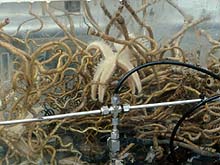
Deep-sea animals, such as this starfish and these tubeworms, were collected during the cruise.
Gulf of Mexico Deep-Sea Biology
February 9-16, 2003
Craig Young, Principal Investigator
University of Oregon
During this Gulf of Mexico cruise, 12 students from the University of Oregon had the opportunity to study deep-sea biology on a scientific research vessel. The National Science Foundation ![]()
![]() , NOAA's Office of Ocean Exploration
, NOAA's Office of Ocean Exploration ![]() (OE), and NOAA's Undersea Research Center at the University of North Carolina-Wilmington sponsored the cruise. The students' travel expenses were covered by a grant from Oregon Sea Grant
(OE), and NOAA's Undersea Research Center at the University of North Carolina-Wilmington sponsored the cruise. The students' travel expenses were covered by a grant from Oregon Sea Grant ![]()
![]() . Our primary research objective was to study the reproductive biology and biochemistry of cold-seep mussels and other deep-sea animals that reproduce seasonally, a continuation of work conducted on the OE-sponsored 2002 Gulf of Mexico expedition. Collaborators from the Southampton Oceanography Centre in the United Kingdom, the University of Virginia, and the University of Tromso in Norway also participated in the cruise.
. Our primary research objective was to study the reproductive biology and biochemistry of cold-seep mussels and other deep-sea animals that reproduce seasonally, a continuation of work conducted on the OE-sponsored 2002 Gulf of Mexico expedition. Collaborators from the Southampton Oceanography Centre in the United Kingdom, the University of Virginia, and the University of Tromso in Norway also participated in the cruise.
Despite the poor weather conditions during this wintertime cruise, each student made at least one dive in a Johnson Sea-Link II submersible. Students were briefed on the dive objectives, instructed in proper data collection procedures, and asked to complete standard log forms for their dives. Deep-sea animals collected by the submersible and maintained in shipboard cold rooms were used for student projects. Many of these projects were ultimately presented at the 10th Deep-Sea Biology Symposium. Lectures were given in the shipboard laboratory, and students were trained in many conventional over-the-side oceanographic methods. including MOCNESS tows, CTD casts, and benthic trapping. In addition, students received training in digital photomicrography, epifluorescence microscopy, and the use of acoustic releases for deep-sea deployments.
Mussels, tubeworms, fileshell clams, snails, and other common seep animals were at the height of their reproductive season during our mid-winter cruise. Some of the animals encountered had not been seen in their reproductive state on cruises that took place at other times of year. A major discovery made on this cruise was that Acesta bullisi, a clam living commensally on the tubes of siboglinid tubeworms, makes its living by consuming the eggs of its host. This unique symbiosis explains the close isotopic connection between the clam and its host that had been observed previously. Also, during and following this cruise, the embryology of two species of seep mollusks was described for the first time. One of the students discovered that a common orbinid polychaete worm, which lives in brine seeps, has a tremendously high tolerance to salinity, befitting its lifestyle and habitat. In addition, we encountered deep-water corals on several dives, and work was initiated to characterize their forms and habitats.









